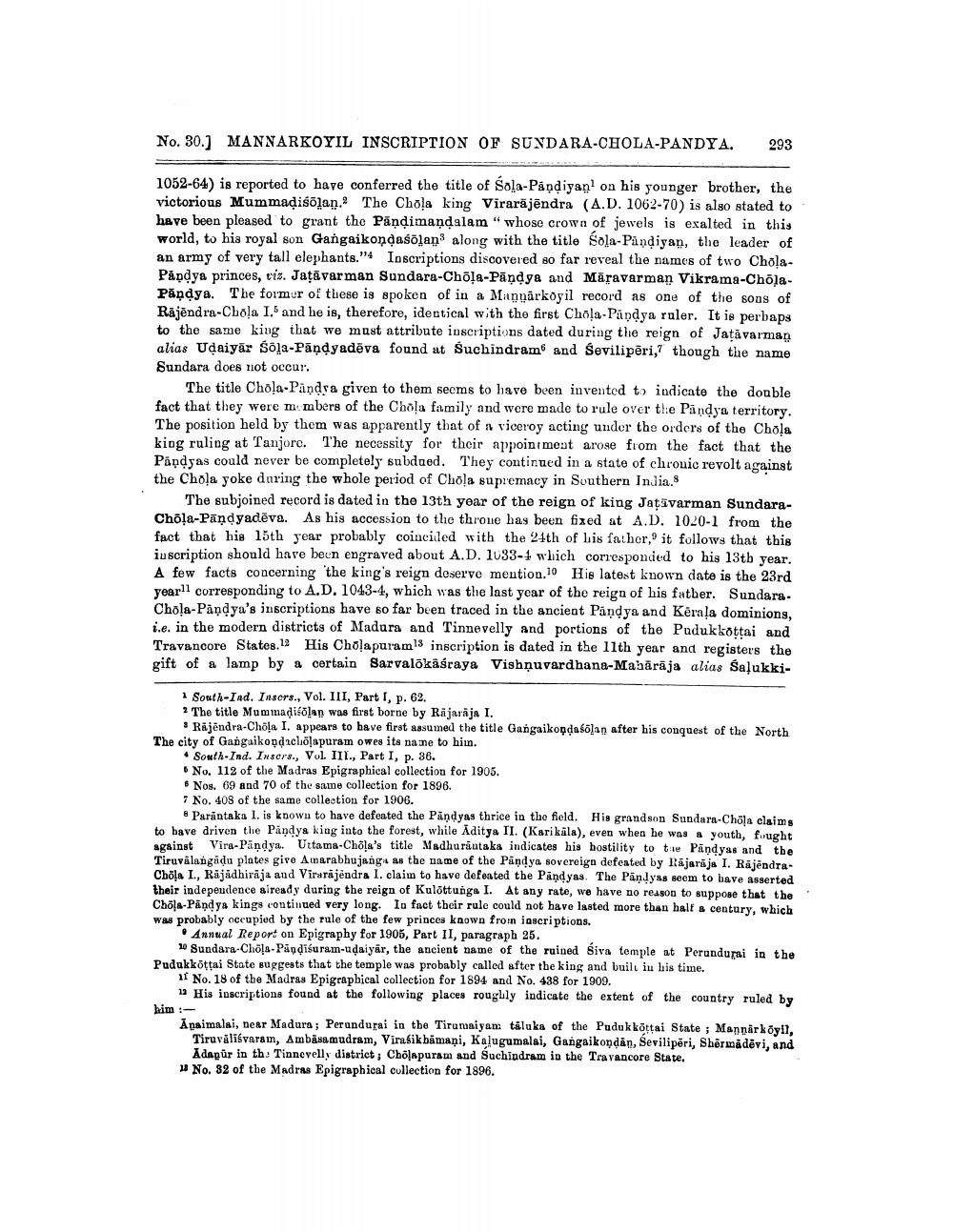________________
No. 30.] MANNARKOYIL INSCRIPTION OF SUNDARA-CHOLA-PANDYA.
1052-64) is reported to have conferred the title of Sola-Pandiyan1 on his younger brother, the victorious Mummaḍiśōlan. The Chola king Virarajendra (A.D. 1062-70) is also stated to have been pleased to grant the Pandimaṇḍalam "whose crown of jewels is exalted in this world, to his royal son Gangaikonḍasolans along with the title Sola-Pandiyan, the leader of an army of very tall elephants."4 Inscriptions discovered so far reveal the names of two CholaPandya princes, viz. Jaṭavarman Sundara-Chōla-Pandya and Maravarman Vikrama-ChōlaPandya. The former of these is spoken of in a Mannarkoyil record as one of the sons of Rajendra-Chola I.5 and he is, therefore, identical with the first Chola-Pandya ruler. It is perhaps to the same king that we must attribute inscriptions dated during the reign of Jaṭāvarman alias Uḍaiyar Sola-Pandyadeva found at Suchindram and Seviliperi, though the name Sundara does not occur.
293
The title Chola-Pandya given to them seems to have been invented to indicate the double fact that they were members of the Chola family and were made to rule over the Pandya territory. The position held by them was apparently that of a viceroy acting under the orders of the Chola king ruling at Tanjore. The necessity for their appointment arose from the fact that the Pandyas could never be completely subdued. They continued in a state of chronic revolt against the Chola yoke during the whole period of Chola supremacy in Southern India.8
The subjoined record is dated in the 13th year of the reign of king Jaṭivarman SundaraChōla-Pandyadeva. As his accession to the throne has been fixed at A.D. 1020-1 from the fact that his 15th year probably coincided with the 24th of his father, it follows that this iuscription should have been engraved about A.D. 1033-4 which corresponded to his 13th year. A few facts concerning the king's reign deserve mention.10 His latest known date is the 23rd yearll corresponding to A.D. 1043-4, which was the last year of the reign of his father. Sundara. Chola-Pandya's inscriptions have so far been traced in the ancient Pandya and Kerala dominions, i.e. in the modern districts of Madura and Tinnevelly and portions of the Pudukkottai and Travancore States. 12 His Cholapuram13 inscription is dated in the 11th year and registers the gift of a lamp by a certain Sarvalōkāśraya Vishnuvardhana-Mahārāja alias Salukki
1 South-Ind. Insers., Vol. III, Part I, P. 62.
2 The title Mummadisōlan was first borne by Rajaraja I.
Rajendra-Chola I. appears to have first assumed the title Gangaikonḍaśölan after his conquest of the North The city of Gangaikoṇḍacholapuram owes its name to him.
South-Ind. Insers., Vol. III., Part I, p. 36.
No. 112 of the Madras Epigraphical collection for 1905..
Nos. 69 and 70 of the same collection for 1896.
7 No. 408 of the same collection for 1906.
Parantaka 1. is known to have defeated the Pandyas thrice in the field. His grandson Sundara-Chōla claims to have driven the Pandya king into the forest, while Aditya II. (Karikala), even when he was a youth, fought against Vira-Pandya. Uttama-Chola's title Madhurautaka indicates his hostility to the Pandyas and the Tiruvalangadu plates give Amarabhujanga as the name of the Pandya sovereign defeated by Rajaraja I. RajendraChola I., Rajadhiraja and Virarajendra I. claim to have defeated the Pandyas. The Pandyas seem to have asserted their independence aiready during the reign of Kulottunga I. At any rate, we have no reason to suppose that the Chola-Pandya kings continued very long. In fact their rule could not have lasted more than half a century, which was probably occupied by the rule of the few princes known from inscriptions.
Annual Report on Epigraphy for 1905, Part II, paragraph 25.
10 Sundara-Chola-Pandisuram-udaiyar, the ancient name of the ruined Siva temple at Perundurai in the Pudukkottai State suggests that the temple was probably called after the king and built in his time.
1f No. 18 of the Madras Epigraphical collection for 1894 and No. 438 for 1909.
12 His inscriptions found at the following places roughly indicate the extent of the country ruled by
kim :
Anaimalai, near Madura; Perundurai in the Tirumaiyam taluka of the Pudukkottai State; Mannarköyil, Tiruvälisvaram, Ambasamudram, Virasik bämani, Kalugumalai, Gangaikondan, Seviliperi, Shermadevi, and Adapur in the Tinnevelly district; Cholapuram and Suchindram in the Travancore State. No. 32 of the Madras Epigraphical collection for 1896.




